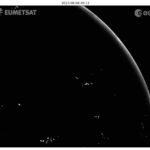The European Space Agency (ESA) has unveiled a groundbreaking weather satellite equipped with innovative technology that harnesses lightning data to enhance weather monitoring capabilities. This cutting-edge satellite aims to revolutionize our understanding of atmospheric phenomena and improve weather forecasting accuracy, providing valuable insights into severe storms and their potential impact on society.
The Lightning-Focused Satellite:
According to a recent article in The New York Times, the ESA’s weather satellite is equipped with advanced sensors specifically designed to detect and analyze lightning activity across the globe. By monitoring lightning strikes in real-time, scientists and meteorologists can gather valuable information about thunderstorms, their development, and associated weather patterns. This data will enable more accurate predictions of severe weather events, ultimately enhancing early warning systems and mitigating potential risks.
Enhanced Weather Monitoring:
Traditional weather monitoring relies heavily on ground-based sensors and radar systems, which have limitations in coverage and accuracy. The incorporation of lightning detection capabilities into the ESA’s satellite enables a broader and more comprehensive view of atmospheric conditions, providing critical information on storm intensity, precipitation patterns, and cloud dynamics. By combining this lightning data with other weather observations, meteorologists can gain a more holistic understanding of weather systems and make more informed predictions.
The Benefits of Lightning Data:
Lightning serves as a powerful indicator of atmospheric instability and the presence of convective activity. By monitoring the frequency, intensity, and location of lightning strikes, scientists can better anticipate the development of severe weather phenomena, such as thunderstorms, tornadoes, and hurricanes. This information is particularly valuable for regions prone to frequent and intense weather events, as it allows for timely evacuation efforts, resource allocation, and disaster response planning.
Advancing Weather Forecasting:
The ESA’s weather satellite is expected to contribute significantly to the advancement of weather forecasting capabilities. By integrating lightning data into numerical weather prediction models, meteorologists can refine predictions of storm tracks, precipitation amounts, and the potential for severe weather hazards. Improved accuracy in weather forecasting benefits various sectors, including aviation, agriculture, emergency management, and general public safety.
Future Implications:
The launch of the ESA’s lightning-focused weather satellite marks a significant milestone in weather monitoring and prediction. As technology continues to evolve, there is potential for further advancements in the integration of satellite data, machine learning, and artificial intelligence, leading to even more precise and timely weather forecasts. The ESA’s initiative serves as a stepping stone for future innovations in weather observation and modeling, ultimately increasing our ability to understand, predict, and adapt to changing weather patterns.
Conclusion:
The ESA’s weather satellite, equipped with lightning detection capabilities, promises to revolutionize our understanding of atmospheric dynamics and improve weather forecasting accuracy. By harnessing lightning data from across the globe, scientists can gain valuable insights into severe weather systems, enhancing early warning systems and mitigating potential risks. This cutting-edge technology represents a significant step forward in weather monitoring and paves the way for future advancements in weather forecasting and disaster preparedness.



